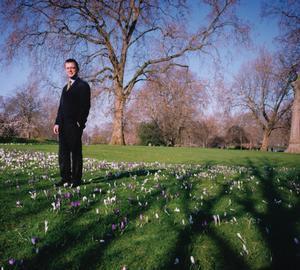A degree in engineering at the University of Western Australia was followed by a ten-year stint at Lincoln Scott, one of the major consultancies in Australia. "The largest project I worked on was the Crown Casino in Melbourne. It's one of the largest buildings on the southern hemisphere and the turnover on the project was bigger than all our other offices put together. I was head of mechanical engineering and second in charge on the whole project." It was while working on this scheme that Logan came to the attention of Connell Wagner: "They were structural engineers on the casino project and that's how we got to know each other." Around this time Connell Wagner were doing several high profile sports projects, including the Docklands stadium, the Vodafone arena and the new stand at Flemington racecourse, home of the prestigious Melbourne Cup race. It is no surprise then, that in their new guise as Connell Mott MacDonald, they are consulting services engineer on the new and highly publicised Wembley stadium.
Growing the business
It was Logan's task to come to London in 2001 to set up the new office after preparations had been made for the alliance between the two organisations: "The common objective between Connell Wagner and Mott MacDonald was to grow our share of the business. It was about recognising that the business is getting more global. People are doing more and more work internationally and they want that consistency of service. We can now just about put a project team anywhere."
It's this global perspective that has bred the business ethos of Connell Mott MacDonald, as Logan explains: "You can't have good specialists everywhere, so the business model is: good generalists all over the world supported by good specialists. Wembley is a classic example. We did so many sports facilities in Australasia, it was smart to use that expertise, so the mechanical services were actually done in Melbourne. As it panned out, in the second round, some of the mechanical engineers have been over here so it was done in London. But that's the idea, rather than rely on the generalists to do everything, you support them with the people who have that specialist expertise. It's more efficient if you bring the work to the people, nobody works effectively if you take them away from their home for six months."
A model approach
The company's system of integrated modelling is also a trademark of these principles. Their in-house translation software allows for all the simulation work to be done from one central model by staff in any of their offices. "The cost savings are huge. Two thirds of the cost of simulation are building the model, but with the translation package, which we're pretty sure no-one else is doing, we can offer a host of additional services at much reduced cost to a client that, say, only initially required a natural ventilation model. We've taken that approach successfully on four or five projects already and we've only had this going less than a year."
Logan also explains that the firm has begun to do modelling at an earlier stage on projects: "We're doing a lot more rough and ready models early. People don't want to do any modelling until the architectural geometry is fixed because of the cost of having to start again, but we think that is bad consulting. You're not giving input to the architects when they need it. So we're getting a lot better at doing rough models, testing concepts to see if things will work. We're even doing simulation design at competition level, and that's actually led us to win jobs because we've shown the end results. Our approach is everybody using the tool supported by specialists."
Logan also points out that this 'get in early' attitude is an integral part of the organisation's whole approach to successful consulting. "When the architect has got his thick black pencil out and he's working out what the building will look like, a good consulting engineer will be advising then, not waiting until the design is semi-closed. The value that a consultant gives a project is in the first 10%, at concept stage. I think modelling is going to stop becoming a specialism and start being something everyone has to use. Clients are already expecting it and that's why we're trying to steal a march on it."
Source
Building Sustainable Design





















No comments yet